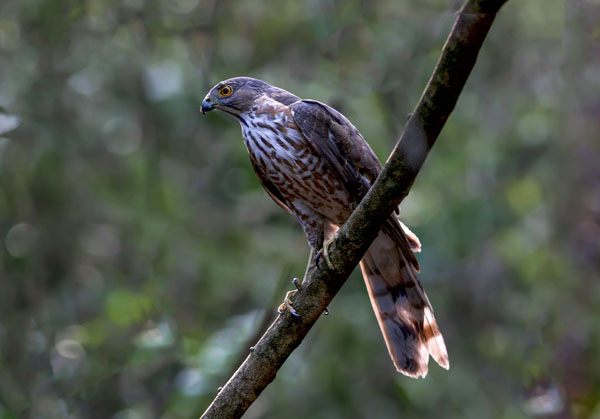Accipiter virgatus
IUCN
LCBasic Information
Scientific classification
- name:Accipiter virgatus
- Scientific Name:sparrowhawk, pine hawk, chest-wagging, sparrow thief, sparrowhawk
- Outline:Raptor
- Family:Accipitriformes Accipitridae Accipiter
Vital signs
- length:28~38cm
- Weight:160~192g
- lifetime:10year
Feature
Alert, timid and fearful
Distribution and Habitat
In my country, it is distributed in Southwest China, South China, Taiwan Island and Central China. In recent years, there have been many records in the north. The individuals recorded in the Beijing raptor migration monitoring show a standard migration state, which is worth noting. Abroad, it is distributed in the Indian subcontinent, Indonesia and the Philippine Islands.
Distributed in dense coniferous forests, evergreen broad-leaved forests and open areas at the edge of forests, and also in mountains, hills and bamboo gardens in winter.
Appearance
Small bird of prey. The male is obviously smaller. Five wing fingers are visible when flying. The plumage of male and female is similar, but the male has a gray face and the female has a brown face.
This species is larger than the Japanese Sparrowhawk, and its body color and shape are highly similar to those of the Japanese Sparrowhawk, but the midline of the throat of this species is obviously thicker than the latter, the horizontal stripes on the body are thicker, and the wing fingers seem to be thicker, and the protruding arc of the rear edge of the wing is also more obvious. There is a brown vertical stripe in the center of the chest of the adult bird, and the vertical stripes on both sides of the chest gradually change from the young vertical stripes to horizontal stripes or connected color blocks, similar to the crested eagle; the immature bird has a vertical stripe on the chest, and there are also vertical spots on the abdomen, and horizontal stripes on the flanks, which
Details
Sparrowhawks are secretive, alert, timid and difficult to observe. Once in the air, they become aggressive and aggressive, and like to provoke and drive away other birds and raptors. During the breeding season, many birds can be seen flying together. Their calls are quite iconic, a series of sharp chirps, the first one is longer, followed by short continuous sounds. When the chicks are hungry, they make a repeated cry of "shew-shew-shew".

They often move and forage alone or in pairs in relatively open places such as forest edges and jungle edges. They are alert. Often standing on the top branches of tall dead trees at the edge of the forest, waiting for and attacking passing birds, and occasionally making sharp calls. Flying fast, also good at gliding. Likes to prey on small birds, and there are also records of attacking pigeons and doves. In addition, it often catches lizards, rodents, insects, etc. Standing quietly in the forest, waiting for an opportunity to find reptiles or birds.
Feeds on various small birds, and also eats lizards, locusts, grasshoppers, beetles and other insects and small rodents, and sometimes even kills quail and small and medium-sized birds such as pigeons and doves.
Migration: resident birds, a few migrate.
Breeding season is from April to June. Nesting in the upper part of tall trees with lush branches and leaves in dense forests, the position is high, and there are branches and leaves to hide, generally difficult to find. The nest is mainly made of thin branches, with some green leaves inside, and old nests are often repaired and reused.

Listed in the "National Key Protected Wildlife List": National Second Class Protected Animal (effective December 10, 1988).








